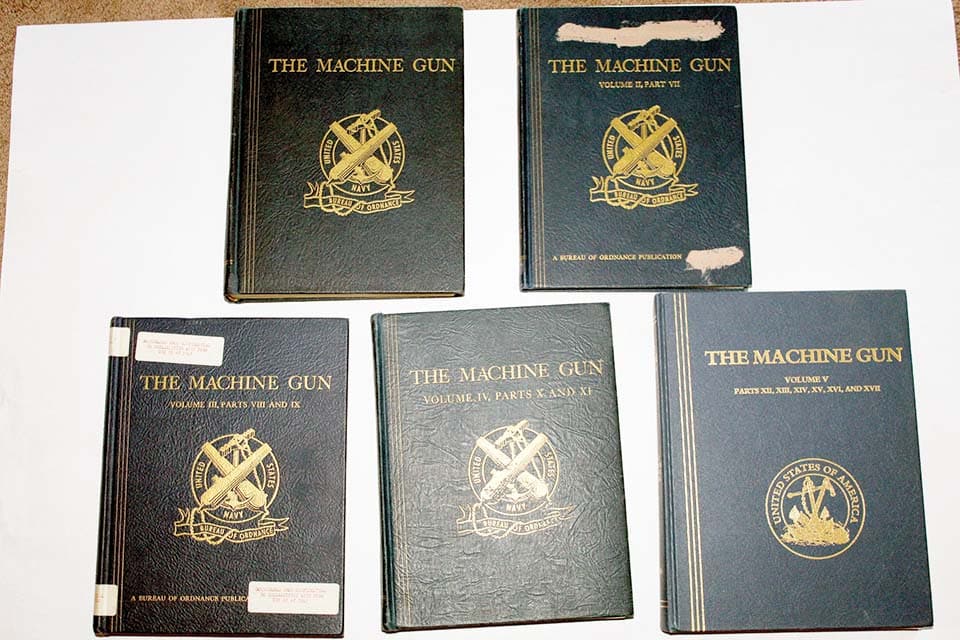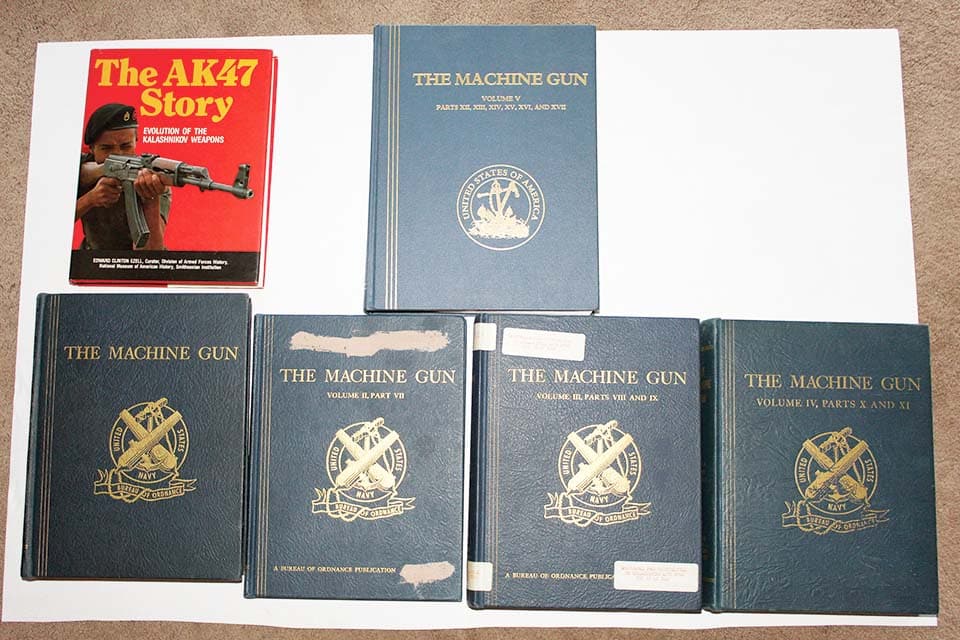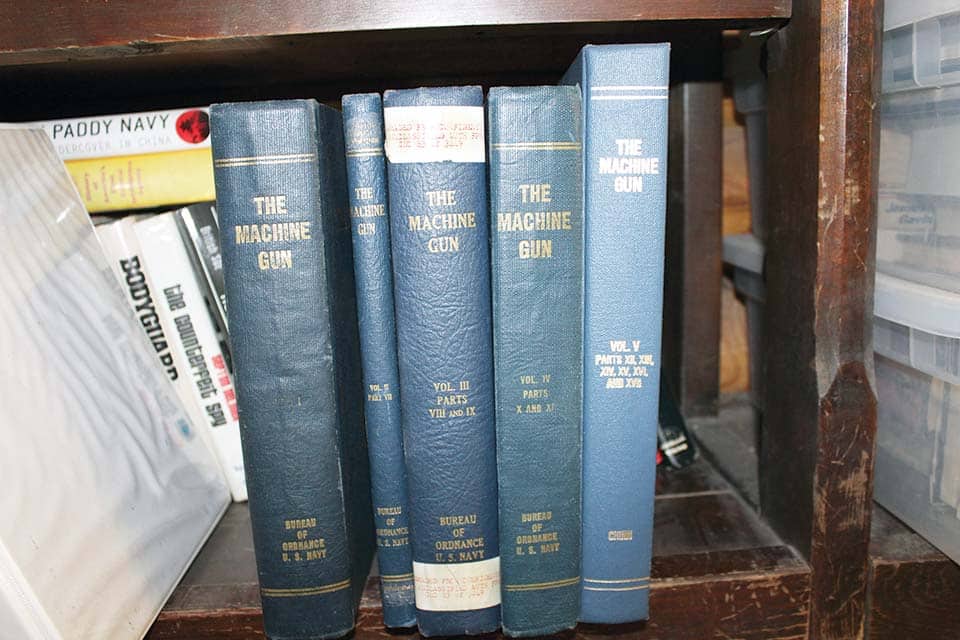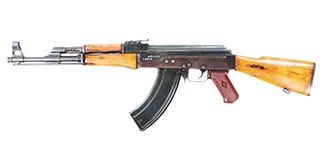By Seth R. Nadel
The AK-47 is an amalgam of several older systems which, when assembled into the rifle, is greater than the sum of its parts—for the Soviet Union of the 1940s and 1950s, and even into the 1980s, a near perfect tool for its people and armies. The people were un- and under-educated, drafted in large masses for “The Great Patriotic War” (World War II everyplace outside the Soviet Union). They were uneducated to the point that many had never seen a machine beyond a simple wagon. There are many tales of Russian troops stealing faucets from homes in occupied areas and being surprised when they stuck them into the wall of the hovels, turned on the faucet, and no water came out.
Their leader, Joseph Stalin, is quoted as saying that “Quantity has a quality all its own.” Certainly his massive armies won many battles because of their sheer numbers, rather than any tactical genius. Stalin had depopulated his officer corps of anyone who may have even thought of resisting his orders, or who was of the wrong background. He espoused the idea that the common man was as capable as any intelligent, educated man—the despised “intelligentsia.”

Type 3 was the most common standard production model.
The Rifle
As of 1986, it was believed that 30 to 50 million AKs had been produced; today it is probably twice that number. The AK is a gas-operated, turning bolt, semi- and fully automatic firearm, fed from a 30-round detachable magazine. The Model 1947 was designed around the 7.62×39 cartridge, which was based on the German 7.92 Kurz (short) round. In this country, the semiautomatic versions are almost universally called “AKs,” even without the full-auto feature. A sidelight to its design is that purportedly, Stalin ordered the caliber so the barrels could be made on existing machinery for the M1891 7.62×54 rimmed cartridge, to be sawn in half prior to being chambered for the shorter round. These and the bullets could be made on existing machines after a minor adjustment.
The two items that are most criticized are the short stock and the safety arrangement. The short stock is easy to explain. Most Russians were short (as were most Americans in those days); more so in Russia due to their food production, food distribution problems and limited diet. In addition, Russia’s greatest ally in history has always been “General Winter,” when the troops would have to wear thick, heavy clothing to survive. Keep in mind that a tall person can easily, if not totally comfortably, shoot a short-stocked rifle, while a short person can have great difficulty shooting a long-stocked rifle.

Type 2 AK-47.
As for the safety, which is only present on the right side? The author can only speculate that it may have been placed to keep the un-/under-educated peasants from “accidentally” shooting each other—or their officers.
In any event, the large tolerances built into the design, along with its being somewhat “overgassed” with more operating power than really needed, put a very reliable weapon into the hands of the troops.
The Official Tale
In keeping with Stalin’s beliefs, the official history of the designer, Mikhail Timofeyevich Kalashnikov, presents him as the son of a poor but noble peasant family. In The AK-47 Story by Edward C. Ezell, he comments that even in an East German article, the reader is “presented with an interesting mixture of fact and fiction” about the designer. Keep in mind that dates of birth were “moveable” in the USSR, if required by The State. While a “self-made man,” he still needed the assistance of the Party and his comrades to perfect his design.
In the official version, he worked for the railroad before enlisting into the Army in 1938. His interest in things mechanical was, of course, recognized by his officers and the Party, and he was trained as an armorer before his training as a tank driver. They claim that during his tank training, he invented both a way to measure gas consumption and new tracks for tanks.
Promoted to Sergeant, he was appointed to supervise the manufacture of his inventions. He was later sent to an active tank unit, where he was wounded in action. While in the hospital, he thought he could help the Motherland by designing better guns. He was given a book obtained by his nurse, written by another Russian firearms inventor, Federov, published in 1939 on the evolution of small arms.
Kalashnikov was given 6 months to heal and went to visit his friends at the railroad, where he announced he wanted to build a working model of a submachine gun he had designed. With the assistance and permission of the local Communist Party, he was allowed to proceed. This lead to his assignment to a design bureau and ultimately to the design of the AK-47.

But Is It True?
At this point, let me add some observations about the “official” tale.
The poor but honest peasant being recognized by The Party and elevated to a high level is a recurrent story in Soviet literature of the time. Here, Kalashnikov fits the mold perfectly—a bit too perfectly. It was a common theme in the Communist ideology, but here it fails.
After the 1918 Russian Revolution, landowners and the intelligentsia were purged from the society. The definition of intelligentsia was … flexible. Anyone with a college degree was included, along with Jews, shop owners and people who were well-read. In some areas, if you wore glasses you were included—the only reason to wear glasses would be to read, so you went off to the gulag or the firing squads. The “common man” was to be exalted. They were the “proletariat” or “proles.”
In the Soviet Union, any information about places or people was SECRET! There were few people with telephones and no public telephone books. There were also no maps of any place in the entire country, other than for ranking party members. Even asking about a person or place (or telephone number) could mean an unhappy meeting with the internal security police. Everyone was required to be an informant.
All information on weapons design was classified—highly classified. The idea that Kalashnikov’s nurse could nip down to the local library and bring him such a book is a flimsy construct. In fact, had she even asked about books on weapons design, she would have had a very uncomfortable interview with the KGB—the internal security police. Then Kalashnikov would have had a similar interview. At best, they may have both been sent to Siberia and the gulag. More likely, they both would have been shot as spies.

Then, for him to get 6 months to heal is ludicrous. He had a shoulder wound, when the Soviet Union was rounding up every available body to go to the Front and were publicly celebrating soldiers with far more serious wounds who fought on. Of course, he is portrayed as asking to be sent back to the Front when told he would be placed on leave, ever the faithful servant of The Motherland.
Finally, the very idea that his friends at the railroad shop could get permission to make any kind of firearm is unbelievable. They too would have been rounded up, along with the local party officials who gave permission, and shot as “counter-revolutionaries” and “enemies of the State.” The KGB officers would have been given medals and promoted for “eliminating these criminals.”
An Alternative Possibility
Here in the U.S., well into the 1960s, there was great fear of another war. The author recalls “Air Raid Drills” in grade school. When the sirens went off, we had to hide under our desks to “protect” us. Living 30 miles from a major target, it is unlikely that a school desk would have saved the author. Information about the Soviet Union and its guns was near impossible to obtain, other than in W.H.B. Smith’s Small Arms of the World (originally printed in paperback as A Basic Manual of Military Small Arms in 1943).
In Russia, mere possession of even a piece of paper from any of the many “Development Bureaus” would mark you as a spy. After you were tortured for the source of the paper, you would be shot. There were “closed cities” for weapons development, which officially did not exist. Weapons designers went in, but they never came out—alive. Asking a question—any question—about such a place would send you to Siberia.
Most of our data on Russian firearms came from humans—“HUMINT” in today’s language. A whisper here, an overheard conversation there and almost nothing on paper. We actually paid big rewards to Russians or “third-party nationals” who could give us data on weapons development behind the Iron Curtain.

Why Disbelieve the Soviet Tale?
So, why would this author believe Kalashnikov was NOT just a humble tank Sergeant? Because of a minor note in a formally classified U.S. government publication. When you write about military firearms history, you read a lot of “unusual” publications. In fact, you start to haunt bookstores and thrift shops, looking for old books on guns. My searching of the latter lead me to a complete set of a U.S. Navy Bureau of Ordnance books titled simply The Machine Gun, by Col. George Chinn, USMC. This is a complete history of repeating firearms, and Volumes II through V were classified “Confidential Security Information” when they were first published in the 1950s. Volume I dealt with the early evolution of firearms and the mechanical machine guns (Gatlings) and self-powered guns through World War I, so it was not classified.
After reading the 680 pages of Volume I, I read the much smaller (200 pages) Volume II, Weapons Development in the Soviet Union and her Satellites. On page 25, there are a few sentences that throw a possible new light on the weapon designer. In a discussion of the “Maxim–Tokarev” (MT) machine gun in 1928, the following paragraph appears:
In competition with the M–T was another version of the Maxim. This gun was modified by Koleshnakov and therefore called the M–K (Maxim–Koleshnakov). It differs outwardly from the M–T in the shape of the stock, but otherwise there is little difference. Koleshnakov was not successful in securing adoption of this weapon, but enough were made for trial to allow its use in the Spanish Civil War.
A designer of the same name is credited with the development, some years later of a machine gun mount for a caliber 12.7mm gun …
In an age when HUMINT was the primary source of information, is it possible that the name was spelled phonetically? How many of us refer to the AK as the “Koleshnakov?” Non-native Russian speakers were and are rare, and were rarely trusted. After all, why would someone know Russian, unless he was a spy? Even a minor typing error at some point could convert a written “a” to an “o,” or an “e.”
Which Tale Is True?
Could the “official tale” be true? Possibly, but unlikely for the reasons listed above. Could the author be wrong? OF COURSE! Neither “Koleshnakov” nor “Kalashnikov” are listed in the index of any of the 5 volumes of The Machine Gun. A Russian speaker of my acquaintance has said that “Koleshnakov” is an odd name in Russian—not familiar in any way to him.
Ultimately, it makes no difference. The AK-47 and its follow on guns are highly successful, both individually reliable and as instruments of Socialist/Communist ideology. When you find an AK series gun, if all the parts are there, no matter their condition, the gun is likely to work.
Now, this author needs to search for more nuggets of information in the remaining 2,028 pages of The Machine Gun, while looking for other obscure titles.
| This article first appeared in Small Arms Review V24N4 (April 2020) |












